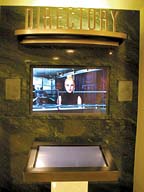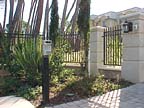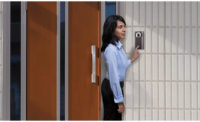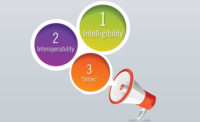For example, an intercom system at one of the three office buildings in the Great American Plaza in Las Vegas features a virtual character on a television screen named Victoria who functions as a receptionist. At an office building in Chicago, intercoms provide access only to an unattended lobby and designated floors of the facility.
A dealer in Brooklyn, N.Y., uses telephone interface intercom systems almost exclusively for buildings with at least 20 tenants. In Foster City, Calif., a telephone interface intercom system remotely controls two gates to a California home.

Victoria the avatar greets visitors to the Great American Plaza office building in Las Vegas, directs them to their destinations and even makes small talk while they wait.
Avatar on the intercom
Walk up to one of the three office buildings in the Great American Plaza in Las Vegas after hours and Victoria will greet you.Appearing on the screen of the building’s intercom system, Victoria, who resembles an avatar in a video game, will ask you to select the name of the business you wish to visit from an alphabetical list using a touch screen.
Touching the screen will connect you with someone in the office you selected who can speak with you and buzz you in and, depending on the equipment set-up in the office, may also be able to see your image on a computer screen.
Victoria will tell you where inside the building your destination office is located. If the person you wish to see has left the office for the day but wants to keep in touch, the system can ring that person’s cell phone. Victoria will guide you through the process.
Since the system was installed in the first half of 2004, it has been a “nice selling tool for tenants,†reports Noam Schwartz. The building is seen as “very sophisticated†and tenants like the sense of security that the system brings them, he adds.
Schwartz is in charge of design and construction for Great American Capital, the real estate developer that owns and manages Great American Plaza and numerous residential and business complexes.
Arrive at Great American Plaza during business hours and you will encounter Victoria on an indoor screen. Here, too, she greets you, asks you to touch the listing for the business you are visiting and then provides directions on how to get there.
An intercom connection to an individual office is not needed while the building is open. Instead, the system provides the functionality traditionally offered by a receptionist or that sometimes is limited to one of those black velvet boards with white plastic letters that lists all the offices in a building.
If you need to wait in the lobby for a while, Victoria will make small talk just like a real receptionist, telling you little-known facts about Las Vegas. “Did you know that palm trees are not native to Nevada but were brought in from California?â€
With Victoria to guide them, “We have nobody wandering the building looking for tenants,†Schwartz maintains, adding that the system has operational benefits, too. “It enabled us to completely computerize the closing and opening of the building,†he notes.
The system at Great American Plaza was installed by Marc Pittman, the director of information technology for Great American Capital. He also helped develop the custom software for the system that runs on an intercom platform from Viscount Systems Inc., Burnaby, British Columbia.
Schwartz, who is an architect by trade, and Pittman helped establish a separate subsidiary of Great American Capital known as Great American Software to develop the custom features.
Great American Capital also has begun to install the system at some of its other properties and has received inquiries from outside companies wishing to install the custom system.

This integrated intercom/access control system allows the lobby inside to be unattended and only gives visitors access to their designated floor.
Intercom and access integrated
When a five-story office building was renovated, the property owner/manager called in Electronic Entry Systems Inc., Winnetka, Ill., to install an intercom system to help secure the downtown Chicago property.“The building has a very nice lobby area that’s unattended,†notes John Dini, president of Electronic Entry Systems. “There’s no receptionist, but there are some nice carpets, chairs and plants, and there could have been a problem with vandalism.†The location on a street with heavy traffic also could have been a target for panhandlers and solicitors.
To secure the property, Electronic Entry Systems installed an integrated intercom/access control system with an LCD directory from Chamberlain's Sentex unit, Elmhurst, Ill. Visitors locate the party they wish to see in the directory, dial the appropriate extension and speak with their party through a hands-free connection to be buzzed in if their visit is authorized.
Once inside, an extra level of security is provided. For example, if someone is visiting a business on the third floor, the elevator only will take the person to that floor. Employees gain entrance to the building using proximity cards, and they too only can gain access to their designated floor.
An interface using Windows software makes it easy for personnel of the property management company to add and delete users and reprogram system parameters as needed. A maintenance person also can reprogram vital system features as needed using a handheld keypad.
“We always suggest a handheld keypad and customers usually go with it,†Dini observes.
Building tenants determine which employees should be listed in the directory and have the ability to release the front door by touching a key on their telephone handset.
Some employees may be listed, but the extension associated with their name actually may reach the company receptionist. Another option is for certain employees to have unlisted extensions, which they give only to those people they want to reach them through the intercom system.
Piggybacks on telephone wires
One of the most important developments in residential intercom systems is the ability to piggyback onto existing telephone wiring. This capability is particularly appealing for multitenant locations such as large apartment buildings.Gold Protective Systems, Brooklyn, N.Y., uses telephone interface intercom systems almost exclusively now for buildings with at least 20 tenants.
A typical Gold installation is one that the company recently completed in an apartment building on New York City’s upscale Upper East Side. The existing intercom system was replaced as part of a complete building renovation.
If Gold had used traditional equipment, technicians would have had to get in touch with each tenant and arrange a time to gain entry to every apartment, which sometimes entails overtime labor rates because tenants insist on an evening appointment. Instead, by installing a controller in the basement, the new system transforms tenants’ existing telephones into multipurpose devices that also can serve as intercom handsets.
“There is no need for double wiring,†asserts Stanley Goldstein, president of Gold Protective. Instead, the system controller is connected to an RJ-71C interface box installed by the local phone company, which connects the system to the apartment building’s phone system.
The new approach has an added benefit for apartment residents. “Now there is not just one location in the apartment where people can answer the front desk, but every phone in the apartment can be used,†Goldstein points out. Some tenants also like the fact that they can let calls from the concierge ring into their voice mail or answering machine if it is inconvenient to talk to the concierge at that particular moment.
To support the call-up only system from Mircom in the Upper East Side apartment building, Gold technicians ran a line from the system controller in the basement to the front desk and to an intercom panel in the lobby that has an LCD readout for each apartment. The door attendant or concierge can push a button to speed-dial any apartment from the intercom panel.
For buildings where call-up and call-down capability is desired, Gold uses a telephone interface intercom system from Ameritech.
Although Gold is finding that some apartment residents are beginning to forego traditional phone service in favor of a cell phone or voice over Internet protocol (VoIP) connection, that usually is not a problem for a telephone interface intercom system, Goldstein maintains.
In virtually every case, the apartment has one or more jacks connected to the building phone system, and residents can plug in a conventional phone that is used strictly with the intercom system.

Residents of this gated home in California can see their guests on CCTV and let them and their vehicles in remotely.
Controls entrance gates remotely
Although telephone interface intercom systems may have made their greatest inroads in multitenant installations, some upscale single-family homes are using them, too.For example, Specialty Controls, Foster City, Calif., recently installed a telephone interface intercom system to control two entrances to a California home whose owner asked to remain anonymous. Each entrance has a vehicle and a pedestrian gate.
An added benefit of the system is that it has access control functionality, enabling residents to release the locks on the entrances from inside the home, assign limited access codes to workers and keep a record of who has entered and left the premises.
Limited access codes enable workers to gain access by entering a code on the keypad installed at each entrance, but only during certain hours or for a limited number of days. The system also can be programmed to unlock the gates at specific times each week to allow for garbage pickup or other regularly scheduled events.
The new system uses Linear, Carlsbad, Calif., equipment that also has a camera built into the controller installed at each entrance. Residents can view images from the camera on their home entertainment system, enabling them to see who is outside either entrance at any time.
The system is a big improvement over the previous one, which had a single keypad with a single code. Locks could not be controlled from inside the home, so residents had to go to an entrance to let in visitors. The intercom system, which operated independently, included two dedicated stations inside the home. For a sprawling home like this one, that was not too convenient.
Now, points out Keith Parker, owner of Specialty Controls, “The client likes the convenience of being able to answer any phone in the house and to have visual contact with the gate.†The client also is pleased with the look of the system. “It fits the whole décor,†Parker observes.
Specialty Controls was able to reuse existing wiring for the new system but had to relocate equipment so that visitors arriving by car could use the system without getting out of their vehicles. Family members have garage-door-style openers that they can use to control the vehicle gates.

